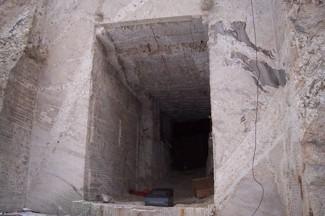A short newspaper article caught my eye awhile ago. It had mentioned that the movie production for National Treasure 2: Book of Secrets had asked permission to shoot at the Mount Rushmore National Monument in a place called the Hall of Records. I had never heard of the Hall of Records. I probably would have forgotten about the news article except a Park Service friend of mine came through town, and told me he had actually visited the Hall of Records. Now I really wanted to know more about this place. So, I called the park. Assistant Chief of Interpretation, Rhonda Buell Schier, was able to give me some answers.
It turns out that the monument sculptor, Gutzon Borglum, had an incredibly elaborate vision for the mountain that included much more than the four presidential heads we see today. He had wanted to carve the shape of the Louisiana Purchase into the mountain, and inside the shape, carve descriptions of the most significant events in American history. Logistically that plan wasn't going to work out, so he created a new plan for a Hall of Records, with the goal of creating a repository for the story of our country for future civilizations. Documents in this repository would include our nation's charter documents. Borglum had even started blasting and drilling out the cavity in the mountain for this chamber. Funding for the project was coming from the government, and they had asked that Borglum focus his efforts towards completing the faces before any more work was done on the Hall of Records. In 1941, Borglum died, and work on the project effectively came to a halt.
The idea of having a vault didn't die though. Borglum's original plan was revised a bit, but the intent remained, and in 1998, tablets with the story of our nation were sealed in a vault in the unfinished Hall of Records. Sixteen porcelain enamel panels containing the text from the Declaration of Independence, the Constitution, and the Bill of Rights, along with a biography of Borglum, and the story of the presidents, were sealed in a teakwood box, then placed in a titanium vault, and finally sealed shut under the weight of a 1,200 pound granite capstone inside the unfinished hall.
This is not a time capsule. These documents are to remain buried for thousands of years. Borglum literally had it in mind to send the message of our country to future civilizations. He said, "you might as well drop a letter into the world's postal service without an address or signature, as to send that carved mountain into history without identification."
Access to the Hall of Records is closed to the public. Because the Hall is located behind the heads, near the cliffs, public safety is a concern. Part of the story in the National Treasure movie apparently does take place in the Hall of Records, but what appears in the movie may only be aerial shots of the entrance. Set designers in Hollywood will recreate the rest. To get a glimpse of the entrance today, or to learn more about the Hall of Records, Rhonda had suggested this book which is available from the Mt Rushmore bookstore.




Comments
When I first visited Mt. Rushmore in 1975, the video shown to visitors at the park included a segment about the "Hall of Records" and the original intent of its creator, Gutzon Borglum. As I recall (now more than 30 years later), Gutzon wanted to make this a grand and glorious hall housing all of the original key documents of this country (i.e., the Declaration of Independence, the Bill of Rights, the U.S. Constitution) where people could view them.
Some 20 years later, when I visited Mt. Rushmore with my family, I was surprised to see that the National Park Service had removed the segment of the video talking about the "Hall of Records".
I'm certain that the new movie, National Treasure, will stir up renewed interest in the hall and its creator.
JP - Thousand Oaks, CA
I would like to point out a typo above... although many would probably claim the typo to be true:
The document referenced to is NOT the "DECELERATION of Independence", but the "DECLARATION of Independence". I'm wondering how long this typo has been around with out anyone noticing??
Probably as long as our liberties have been undermined and no one seems to notice... hm... [Eds. note: Thanks for the headsup. We've fixed the typographigial booboo. You're the first to spot it -- at least, you're the first readster to tell us about it. The veery next time we see Jeremy we'll be sure to tell him about his mistaken and make him promise never to do it agin.]
We've heard that the carvings were put there to hide something alien or otherworldly or something that our government is hiding regarding aliens or alien spacecraft. Can anyone else elaborate on this?
We've heard that behind Mt. Rushmore, is something hidden by our government, having to do with aliens or alien craft. Is there any truth to this, or has anyone else heard anything of this?
So essentially it's a very elaborate time capsule? Could he not have used a shoebox like the rest of us?
I'm certain that the new movie, National Treasure, will stir up renewed interest in the hall and its creator.